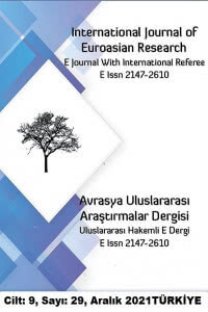TWO INNER ASIAN RIVER NAMES IN TERKH INSCRIPTION
Öz In the part referring to Uyghur khan of Terh inscriptions, constructed in 750‟s, there are place names in poem. Most of these place names are of two big rivers still named in the same way. Per this, it is obvious that Sebin and Teledü in Uyghur khan‟s inscription are river names. In the part about Baya‟ut tribe in “Cami‟ü‟t-Tevarih”, the place where the tribe settled is mentioned. The place names are written in alliteration and recorded in this way. Also, in the part about Baya‟ut tribe, two of the three rivers, flowing from the mountain named Börä Ündürin to Selenge river, are named Kibän and Taladu. Names of these rivers are recorded identical with that in Terh inscription and Câmi„ü‟tTevârîh. The fact that these names appear in these historical artifacts shows not only that these two rivers are very close, but also that they are named through at least 540 years.
Anahtar Kelimeler:
Terkh inscription, hydronomy, Sebin, Teledü
___
- BAZILKHAN, B, (1982) Terkhiyn türeg biçees. // Studia Mongolica. Tom. VIII (15), fasc. 12. Ulaanbaatar: 163-175
- BAZILKHAN, N. (2005) Köné türik bitiktastarı mén éskértkiştéri (Orqon, Éniséy, Talas). In: Khazakhstan tarikhı turalı türki déréktéméléri. II tom. Almatı
- BERTA, A, (2006) Runik harfli Eski Türkçe yazıtlar (VIII yüzyıl). // Türk Edebiyatı Tarihi. C. I. İstanbul
- DAMDINSÜREN Ts. (1987) Mongol ardıın ulamjlalt surgan khümüüjüülekh züygees. // Studia Folclorica. Tom. XIV, fasc. 1. Ulaanbaatar: 3-14
- KATAYAMA A. (1999) Tariat Inscription. In: Provisional Report of Researches on Historical Sites and Inscriptions in Mongolia from 1996 to 1998. Ed. by Takao Moriyasu and Ayudai Ochir. Osaka: 168-176
- KLYAŞTORNIY S.G. (1980) Térkhinskaya nadpis‟ (prédvaritél‟naya publikatsiya). // Sovétskaya Tyurkologiya. 1980, No. 3. Baku: 82-95
- KLYAŞTORNIY S.G. (1982) The Terkhin Inscription. // Acta Orientalia Hungarica. Tom. XXXVI (1-3). Budapest: 335-366
- MERT, O, (2009) Ötüken Uygur Dönemi Yazıtlarından Tes, Tariat, Şine Us. Ankara MÖNKHTULGA, R. (2015) An Inner Asian hydronym of the 13th century in the “Jami„u‟ttawarikh”. International conference “Gerege / paiza – values of Asian civilization in the 7 th -8 th century of Hijry / 13th -14th century”. Summaries of conference papers. Ulaanbaatar: 28-31
- ÖLMEZ, M. (2013) Orhon-Uygur Hanlığı Dönemi Moğolistan‟daki Eski Türk Yazıtları. Metin-Çeviri-Sözlük. Ankara
- PERLEE, Kh. (1964) Ikh khorig khaana bayna. In: D.Perlee. Büteeliyn çuulgan. III. Ulaanbaatar, 2012: 321-326
- PERLEE, Kh. (1969), Gurvan mörniy mongolçuudıın aman tüükhiyn möriyg möşgösön n‟. In: D.Perlee. Büteeliyn çuulgan. I. Ulaanbaatar, 2012: 365-427
- RASHİD-AD-DİN, (1952). Sbornik létopiséy. Tom I, kniga 1. Pérévod s pérsidskogo L.A.Khétagurova. Moskva-Léningrad
- RASHİDUDDİN, Fazlullah‟s (1998) Jamiʻuʼt-tawarikh Compendium of Chronicles. A History of the Mongols. Part One. English translation and annotation by W.M.Thackston. In: Sources of Oriental Languages and Literatures. 45. Central Asian Sources IV. Harvard
- SÜKHBAATAR, O, (2001), Sacred sites of Mongolia. Ulaanbaatar, 2001
- ŞİNEKHÜÜ, M., (1975), Tariatıın Orhon biçgiyn shine dursgal. // Studia Archaeologica. Tom. VI, fasc. 1. Ulaanbaatar, 1975
- ŞİRİN, H. User (2009), Köktürk ve Ötüken Uygur Kağanlığı Yazıtları. Konya
- TEKİN, T (1983b) The Terkhin Inscription. // Acta Orientalia Hungarica. Tom. XXXVII (1-2). Budapest: 43-68
- TEKİN, T, (1983a) Kuzey Moğolistan‟da Yeni Bir Uygur Anıtı: Taryat (Terhin) Kitabesi. // Belleten: C. 66, S. 184: 795-838
- ISSN: 2147-2610
- Yayın Aralığı: Yılda 4 Sayı
- Başlangıç: 2012
- Yayıncı: Kürşat Öncül
Sayıdaki Diğer Makaleler
ORTA DÖNEM MOĞOLCASINDAKİ BAZI İSLAMİ TERİMLER ÜZERİNE
Tseden TSETSEGJARGAL, Sakhiya BOLORMAA
CHOSON HANEDANLIĞI’NDA KORE KAYNAKLARINDA MOĞOL DİLİ ÜZERİNE YAPILAN ÇALIŞMALAR
MOĞOLİSTAN’DA KADIN SİVİL TOPLUM KURULUŞLARI
Tseden TSETSEGJARGAL, Sakhiya BOLORMAA
BİSHRELT-AM BÖLGESİNDEKİ XİONGNU MEZARI
SOME ISSUES OF IMPROVING THE QUALITY OF THE LABOR RESOURCES IN THE REPUBLIC OF KAZAKHSTAN
Almas KURALBAYEV, Serikbay YDYRYS
ÜÇ ÜLKEYE BÖLÜNMÜŞ ÇOK DİLLİ BİR HALK: HAMNİGANLAR VE DİL DURUMLARI
TWO INNER ASIAN RIVER NAMES IN TERKH INSCRIPTION
AVRUPA YEREL YÖNETİMLER ÖZERKLİK ŞARTI ÜZERİNE BİR İNCELEME: TÜRKİYE ÖRNEĞİ
